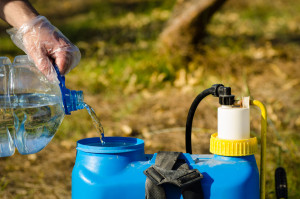Agricultural chemicals
Find out how to safely and legally dispose of used or unwanted agricultural chemicals (agrichemicals) and view a list of banned agrichemicals.
Disposal of used or unwanted agrichemicals
Responsible agrichemical disposal practices protect people and the environment by preventing the contamination of land and potential risks to human health.
Environment Canterbury is a supporter of the Agrecovery programme, ensuring that unwanted chemicals can be taken safely from the farm.
Agrecovery provides a solution for the disposal of unwanted chemicals, and the recycling of empty containers, drums and IBCs.
Visit the Agrecovery website to find out more details on their services.

Common POPs include chlorinated pesticides (organochlorine pesticides) such as dieldrin, DDT, endosulfan, lindane and aldrin.
Banned and illegal agrichemicals
The Environmental Protection Agency (EPA) regulates the importation of hazardous substances into New Zealand.
This includes meeting our international commitments including the Stockholm Convention on Persistent Organic Pollutants (POPs).
POPs are an issue as they remain intact for a very long time and are toxic to both humans and wildlife. POPs are effective at killing organisms so were commonly used as pesticides, insecticides and fungicides.
The Ministry for the Environment provides a list of POPs, their description, and examples of their use in New Zealand.
Common POPs include chlorinated pesticides (organochlorine pesticides) such as dieldrin, DDT, endosulfan, lindane, aldrin, etc.
Rules for managing agrichemicals
The regulatory framework around hazardous substances is complex.
The regulations for managing hazardous substances changed from 1 December 2017.
The major change is that the Environmental Protection Agency is working with WorkSafe New Zealand to ensure substances are managed safely.
This means that the rules to protect people are both regulated and enforced by WorkSafe New Zealand.
The main piece of legislation is the Health and Safety at Work (Hazardous Substances) Regulations 2017 which sit within the Health and Safety at Work Act.
The EPA is the regulator for hazardous substances disposal rules and the rules to protect the environment workplaces. These rules are set in the Hazardous Substances and New Organisms Act 1996. The EPA Notices contain the relevant rules.
Of particular importance are the Hazardous Substances (Disposal) Notice 2017 and the Hazardous Substances (Hazardous Property Controls) Notice 2017 that contain the Class 9 (ecotoxic substances) rules.
A simple way to check which national rules apply for a particular agrichemical is to use the calculator at www.hazardoussubstances.govt.nz.
To get the most accurate information, you should know the maximum quantity of substance which you plan to have on farm, the expected storage location of the substance (outdoors, workroom, hazardous substances store, etc.) and a copy of a current Safety Data Sheet that provides the hazardous substance classifications.
There are other hazardous substances environmental and disposal rules set under the Resource Management Act and local council bylaws (enforced by local, district, and regional councils).

